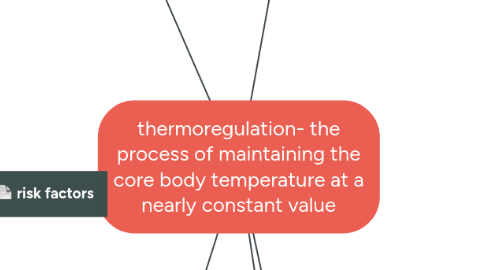
1. pathophysiology- the bodys system is regulated by the hypothalamus ( is sensitive to temperature change inside and oustide of the body) the neurons send signals for the body to respond to according to the change.
1.1. heat production and conservation
1.1.1. produced by muscle movement
1.1.2. basal metabolic activity
1.2. heat loss
1.2.1. conduction
1.2.1.1. transfering when in direct ontact with one another
1.2.2. convection
1.2.2.1. transfer from body to heat via ar current
1.2.3. radiation
1.2.3.1. tranferring to colder objects not in direct contact
1.2.4. evaporation
1.2.4.1. tranferring heat from liquid formation to vapor
1.3. temperature control
2. risk factors
2.1. very young persons
2.2. very old persons
2.3. poor persons
2.4. those in very hot and cold climates
2.4.1. ex: those who work outside
2.5. traumatic brain injury
2.6. diabetics
2.7. malnourishment
2.8. cognitive impairment
2.9. heart failure
2.10. those who are more vulnerable to dehydration
3. interrelated concepts
3.1. intracranial regulation
3.1.1. mental confusion
3.1.2. loss of consciouness
3.1.3. loss of coordination
3.1.4. enlarged pupils
3.2. perfusion
3.2.1. vasoconstriction
3.2.2. makes heart work slower and heart rate falls causing less blood flow to extremeities; tried to keep blood flow close to vital orgasn
3.2.3. increases liklihood of repiratory failure due to circulatory failure
3.3. nutrition
3.4. tissue integrity
3.4.1. skin turning blue and cold
3.5. fluid & electrolytes
3.5.1. renal failure
3.5.1.1. mild
3.5.1.1.1. increased urine output
3.5.1.2. moderate
3.5.1.2.1. blood flow to renal system is reduced byb 50%
3.5.1.3. severe
3.5.1.3.1. renal system loses oxygen supply
3.5.1.3.2. cessation of urine production
4. recognizing the problem
4.1. hypothermia
4.1.1. vasonconstricition occurs in thobody
4.1.2. shivering may occur to produce heat
4.1.3. three stages
4.1.3.1. mild
4.1.3.1.1. shivering, increase in metabolism production, increase in steroid production
4.1.3.2. moderate
4.1.3.2.1. insulin production is halted, metabolism production starts to decrease, severe shivering
4.1.3.2.2. intense shivering
4.1.3.2.3. mental confusion
4.1.3.3. severe
4.1.3.3.1. 80% decrease in metabolism, all metabolic processes are halted and shivering has stopped completely
4.1.3.3.2. uncontrolled breathing
4.1.3.3.3. mental confusion
4.1.3.3.4. loss of coordination
4.1.3.3.5. cold and blue skin
4.1.3.3.6. irregular heeat beat
4.1.3.3.7. weak pulse
4.1.3.3.8. enlarged pupils
4.2. when an individuals temperature is rising higher than required for normal metabolism
4.3. hyperthermia
4.3.1. overgeneration of heat in the body.
4.3.2. the body is producing or absorbing more heat that it can release.
4.3.3. three major stages
4.3.3.1. heat cramps
4.3.3.1.1. fainting
4.3.3.1.2. muscle cramps
4.3.3.1.3. light-headedness
4.3.3.1.4. weakness
4.3.3.2. heat exhaustion
4.3.3.2.1. excessive sweating
4.3.3.2.2. weakness
4.3.3.2.3. vomitting
4.3.3.2.4. nausea
4.3.3.2.5. headache
4.3.3.2.6. muscle cramps
4.3.3.3. heat stroke
4.3.3.3.1. at this stage the body temperature regulation is completely uncontrolled and is accompanied by the breakdown of the nervous system.
4.3.3.3.2. elevated heart rate
4.3.3.3.3. skin turning red
4.3.3.3.4. muscle cramps
4.3.3.3.5. dizziness and hallucinations
4.3.3.3.6. weakness
5. interventions
5.1. hyperthermia
5.1.1. remove excess clothing and blankets
5.1.2. povide external cool packs
5.1.3. provide cooling blanket
5.1.4. hydrate with cool fluids ( PO or IV)
5.1.5. lavage with cool fluids
5.1.6. administer antipyretic drug therapy
5.2. hypothermia
5.2.1. remove the person from cold
5.2.2. provide external warming measures
5.2.3. provide internal warming measures
5.2.4. ** core rewarming must be done slowly to minimize the risk od dysrythmias. cardiac monitoring is required when the patient is recovering from severe hypothermia

